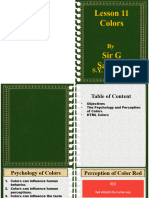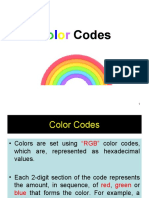0% found this document useful (0 votes)
20 views4 pagesOishiSen
The document discusses the importance of HTML colors in web design, detailing methods for color representation including color names, hexadecimal values, RGB, and HSL. It emphasizes the aesthetic appeal, brand identity, and user experience that colors contribute to a website, while also highlighting tools for color selection and challenges in ensuring accessibility. Best practices for color usage in web design are provided to enhance visual consistency and readability.
Uploaded by
oishis2004Copyright
© © All Rights Reserved
We take content rights seriously. If you suspect this is your content, claim it here.
Available Formats
Download as PDF, TXT or read online on Scribd
0% found this document useful (0 votes)
20 views4 pagesOishiSen
The document discusses the importance of HTML colors in web design, detailing methods for color representation including color names, hexadecimal values, RGB, and HSL. It emphasizes the aesthetic appeal, brand identity, and user experience that colors contribute to a website, while also highlighting tools for color selection and challenges in ensuring accessibility. Best practices for color usage in web design are provided to enhance visual consistency and readability.
Uploaded by
oishis2004Copyright
© © All Rights Reserved
We take content rights seriously. If you suspect this is your content, claim it here.
Available Formats
Download as PDF, TXT or read online on Scribd
/ 4
























































































